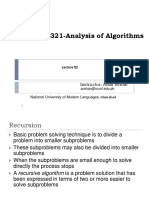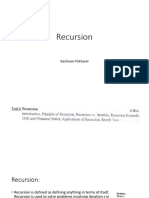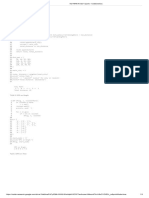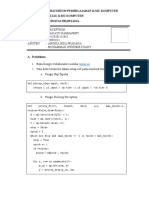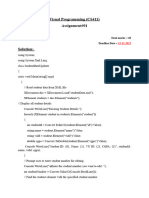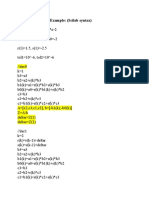Data structures
and algorithms
�DATA STRUCTURES AND
ALGORITHMS
WEEK 2: RECURSION, MEMORIZED RECURSION
3
�CONTENT
• Basic definition
• General recursive diagram
• Analyze recursive algorithms
• Memorized recursion
4
�BASIC DEFINITION
• Recursive object: defined through itself but on a smaller scale
• Recursive function
• Basic step: Determine the value of a function with some initial parameter values
• Recursive step: Determine the relationship between the function depending on the same function but
with smaller parameters
• Basic: F(n) = 1, với n = 1 • Basic: C(k, n) = 1, với k = 0 hoặc k = n
• Recursion: F(n) = F(n-1) + n, with • Recursion: C(k, n) = C(k-1,n-1) + C(k,n-1), for others
n>1
5
�BASIC DEFINITION
• Recursive object: defined through itself but on a smaller scale
• The set is defined recursively
• Basic step: determine the first elements of the set
• Recursive step: determine the rule indicating that larger word parts belong to the set of original
elements
• Basic: 3 belongs to S
• Recursion: If x and y belong to S then x + y
belongs to S
6
�GENERAL RECURSIVE DIAGRAM
A recursive algorithm is an algorithm that calls itself with a smaller input size.
Recursive algorithms are often used when needing to deal with recursively defined objects.
Example: The recursive definition of a Fibonacci sequence:
• f(0) = 0, f(1) = 1,
• f(n) = f(n-1) + f(n-2) with n > 1
High-level programming languages often allow the construction of recursive functions, meaning that the
body of the function contains calls to itself. Therefore, when implementing recursive algorithms, people
often build recursive functions.
7
�GENERAL RECURSIVE DIAGRAM
Recursive(input) {
if (size of input is minimum) then
Do basic steps; /* Solve the problem with the smallest size*/
else {
Recursive(input with smaller size); /* Recursive step for
subproblems*/
/* Note: There might exist other recursive calls*/
Combine results of subproblems to get solution;
return solution;
}
}
8
� EXAMPLE
Example 1: Calculate n! with the recursive formulation: int factorial(int n){
f(0) = 1 if (n==0)
f(n) = n * f(n-1) return 1;
(7) return 6 else
return n*factorial(n-1);
factorial(3): }
3 == 0 ? NO
return 3*factorial(2) (1) In factorial(3)
Call factorial(2)
The execution of factorial(3) will stop when
(6) return 2 factorial(2): factorial(2) returns a result
2 == 0 ? NO
(2) In factorial(2)
return 2*factorial(1)
Call factorial(1) When factorial(2) return a result,
(5) return 1
factorial(3) continues executing.
factorial(1):
1 == 0 ? NO (3) In factorial(1)
return 1*factorial(0)
Call factorial(0)
(4) return 1
factorial(0):
0 == 0 ? YES
return 1
9
�EXAMPLE
Example 2: Calculate the Fibonacci sequence:
F(0) =0; F(1) = 1
F(n) = F(n-1) + F(n-2) với n ≥ 2
int F(int n){
if (n < 2)
return n;
else
return F(n-1) + F(n-2);
}
10
�EXAMPLE: HANOI TOWER
Example 3: Hanoi Tower:
The Tower of Hanoi problem is presented as follows: “There are 3 piles a, b, c. On pile a there is a stack of n
disks, the diameter decreasing from bottom to top. It is necessary to move the stack of disks from pile a to
pile c following the rules:
• Only transfer 1 disk at a time
• Only discs with smaller diameters should be placed on top of disk with larger diameters. During the
transfer process, it is allowed to use pile b as an intermediate pile.
The problem is: List the steps to move the disks that need to be performed to complete the task set out in
the problem.
11
�EXAMPLE: HANOI TOWER
Moving n disks from pile a to pile c using pile b as an intermediary: HanoiTower(n, a, c, b);
Disc movement consists of 3 stages:
(1) Move n-1 disks from pile a to pile b, using pile c as an intermediary
(2) Move 1 disk (the disk with the largest diameter) from pile a to pile c
(3) Move n-1 disks from pile b to pile c, using pile a as an intermediary
Pile a Pile c Pile b
12
�EXAMPLE: HANOI TOWER
Moving n disks from pile a to pile c using pile b as an intermediary: HanoiTower(n, a, c, b);
Disc movement consists of 3 stages:
(1) Move n-1 disks from pile a to pile b, using pile c as an intermediary
Solve a problem of size n-1: HanoiTower(n-1,a,b,c)
(2) Move 1 disk (the disc with the largest diameter) from pile a to pile c
Solve a problem of size 1: HanoiTower(1,a,c,b)
(3) Move n-1 disks from pile b to pile c, using pile a as an intermediary
Solve a problem of size n-1: HanoiTower(n-1,b,c,a)
Pile a Pile c Pile b
13
�EXAMPLE: HANOI TOWER
The algorithm can be described in the following recursive procedure:
HanoiTower(n, a, c, b) {//Move n-1 disks from pile a to pile b, using pile c as an intermediary
if (n==1) then <move a disk from pile a to pile c>
else {
HanoiTower(n-1,a,b,c);
HanoiTower(1,a,c,b);
HanoiTower(n-1,b,c,a);
}
}
Disc movement consists of 3 stages:
(1) Move n-1 disks from pile a to pile b, using pile c as an intermediary
(2) Move 1 disk (the disk with the largest diameter) from pile a to pile c
(3) Move n-1 disks from pile b to pile c, using pile a as an intermediary
14
�EXAMPLE: HANOI TOWER
#include<stdio.h>
int i = 0;
void HanoiTower(int n, char source, char target, char inter)
{
if(n==1){
printf("Move a disk from pile %c to pile %c\n", source,
target);
i++;
return;
} else{
HanoiTower(n-1, source, inter, target);
HanoiTower(1, source, target, inter);
HanoiTower(n-1, inter, target, source);
}
}
int main()
{
int n;
printf("Enter the number of disks n = "); scanf("%d", &n);
HanoiTower(n, 'a', 'c', 'b');
printf("The total number of steps to move disks = %d", i);
return 0;
}
15
�ANALYZE RECURSIVE ALGORITHMS
To analyze recursive algorithms, we usually proceed as follows:
Let T(n) be the algorithm's calculation time
Build a recursive formula for T(n)
Solve the resulting recursive formula to give an estimate for T(n)
In general, we only need a close estimate of the growth rate of T(n), so solving the recursive formula for
T(n) is to give an estimate of the growth rate of T(n) in asymptotic notation.
16
�ANALYZE RECURSIVE ALGORITHMS
Example: Calculate n! with the recursive formula: int factorial(int n){
if (n==0)
f(0) = 1 return 1;
f(n) = n * f(n-1) else
return n*factorial(n-1);
}
Let T(n) be the number of multiplication operations that must be performed in the call to factorial(n).
We have:
T(0) = 0,
T(n) = T(n-1) +1, n≥1
17
�ANALYZE RECURSIVE ALGORITHMS
Example: Calculate n! with the recursive formula: int factorial(int n){
if (n==0)
f(0) = 1 return 1;
f(n) = n * f(n-1) else
return n*factorial(n-1);
}
Let T(n) be the number of multiplication operations that must be performed in the call to factorial(n).
We have:
T(0) = 0,
T(n) = T(n-1) +1, n≥1
18
�ANALYZE RECURSIVE ALGORITHMS
Let T(n) be the number of multiplication operations that must be performed in the call to factorial(n). We
have:
T(0) = 0,
T(n) = T(n-1) +1, n≥1
Solving the recursive formula T(n), we have:
T(n) = T(n-1) + 1 replace T(n-1)
= T(n-2) + 1 + 1 replace T(n-2)
= T(n-3) + 1 + 1 + 1
= T(n-3) + 3
=…
= T(n-k) + k
T(n) = T(n-n) + n Select k = n
= T(0) + n
= n. So that: T(n) = O(n)
19
�MEMORIZED RECURSION
int F(int n){
• Duplicate subproblems if (n < 2) return n;
Example 1: Calculate the Fibonacci sequence : else return F(n-1) + F(n-2);
}
F(0) =0; F(1) = 1
F(n) = F(n-1) + F(n-2) với n ≥ 2
• In a recursive algorithm, every time we need a
solution to a subproblem, we have to solve it
recursively. Therefore, there are subproblems that
are solved over and over again. That leads to
ineffectiveness of the algorithm. This phenomenon
is called duplicate subproblem phenomenon.
20
�MEMORIZED RECURSION
• Duplicate subproblems int C(int k, int n){
if (k == 0|| k == n)return 1;
Example 2: Calculate the binomial coefficient: else return C(k-1,n-1)+C(k,n-1);
}
C(0,n) = 1, C(n,n) =1; for all n ≥ 0,
C(k,n) = C(k-1,n-1)+C(k,n-1), 0 < k < n
21
�MEMORIZED RECURSION
In the two examples above, we have seen that the recursive algorithms for calculating Fibonacci numbers
and calculating binomial coefficients are inefficient.
To increase the efficiency of recursive algorithms, we can use memorized recursion techniques.
Using memorized recursion techniques, in many cases, we can preserve the recursive structure of the
algorithm and at the same time ensure its efficiency. The biggest disadvantage of this approach is the
memory requirement.
22
�MEMORIZED RECURSION
The idea of recursion:
Use a variable to remember information about the solution of subproblems right after the first time it is
solved. That allows to shorten the algorithm's calculation time, because, whenever needed, it can be
looked up without having to re-solve previously solved sub-problems.
23
�MEMORIZED RECURSION
Example 1: Calculate a Fibonacci sequence: Memorized recursion:
void init() {
F(0) =0; F(1) = 1
M[0] = 0; M[1] = 1;
F(n) = F(n-1) + F(n-2) with n ≥ 2
for (int i = 2; i <= n; i++) M[i] = 0;
Non-memorized recursion:
}
int F(int n){
if (n < 2) int F(int n){
return n; if (n!= 0 && M[n] == 0)
else M[n] = F(n-1) + F(n-2);
return F(n-1) + F(n-2); return M[n];
} }
Before calling the function F(n), call the init() function
to initialize the elements in the array M[ ] as follows:
M[0] = 0, M[1]=1,
M[i] = 0, với i ≥ 2.
24
�MEMORIZED RECURSION
Example 2: Calculate the binomial Memorized recursion:
void init() {
coefficient : for (int i = 0; i <= k; i++)
C(0,n) = 1, C(n,n) =1; for all n ≥ 0, for(int j = 0; j <= n; j++) M[i][j] = 0;
}
C(k,n) = C(k-1,n-1)+C(k,n-1), 0 < k < n
int C(int k, int n) {
if (k == 0 || k == n) M[k][n] = 1;
Non-memorized recursion else {
int C(int k, int n){ if(M[k][n] == 0) M[k][n] = C(k-1,n-1) + C(k,n-1);
if (k == 0 || k == n)
return 1; }
else return M[k][n];
return C(k-1,n-1) + C(k,n-1);
} }
Before calling the function C(k, n), call the init() function to
initialize the elements in the array M[ ][ ] = 0
25
�THANK YOU !
26








